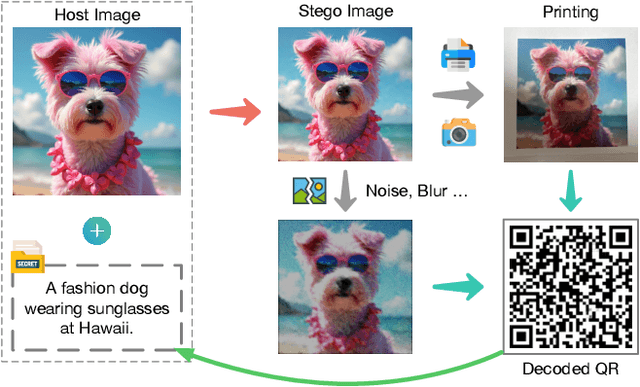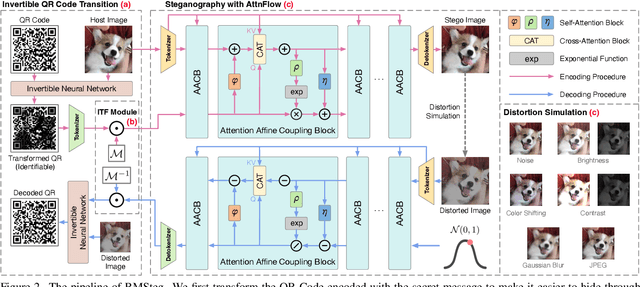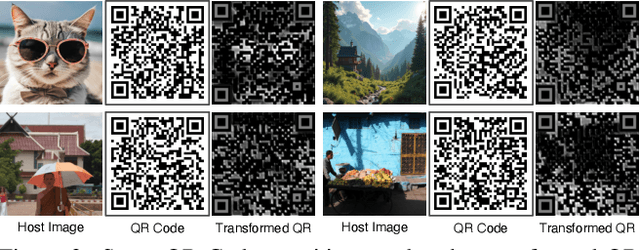Changbo Wang
Mitigating Long-tail Distribution in Oracle Bone Inscriptions: Dataset, Model, and Benchmark
Apr 16, 2025Abstract:The oracle bone inscription (OBI) recognition plays a significant role in understanding the history and culture of ancient China. However, the existing OBI datasets suffer from a long-tail distribution problem, leading to biased performance of OBI recognition models across majority and minority classes. With recent advancements in generative models, OBI synthesis-based data augmentation has become a promising avenue to expand the sample size of minority classes. Unfortunately, current OBI datasets lack large-scale structure-aligned image pairs for generative model training. To address these problems, we first present the Oracle-P15K, a structure-aligned OBI dataset for OBI generation and denoising, consisting of 14,542 images infused with domain knowledge from OBI experts. Second, we propose a diffusion model-based pseudo OBI generator, called OBIDiff, to achieve realistic and controllable OBI generation. Given a clean glyph image and a target rubbing-style image, it can effectively transfer the noise style of the original rubbing to the glyph image. Extensive experiments on OBI downstream tasks and user preference studies show the effectiveness of the proposed Oracle-P15K dataset and demonstrate that OBIDiff can accurately preserve inherent glyph structures while transferring authentic rubbing styles effectively.
GAOKAO-Eval: Does high scores truly reflect strong capabilities in LLMs?
Dec 13, 2024Abstract:Large Language Models (LLMs) are commonly evaluated using human-crafted benchmarks, under the premise that higher scores implicitly reflect stronger human-like performance. However, there is growing concern that LLMs may ``game" these benchmarks due to data leakage, achieving high scores while struggling with tasks simple for humans. To substantively address the problem, we create GAOKAO-Eval, a comprehensive benchmark based on China's National College Entrance Examination (Gaokao), and conduct ``closed-book" evaluations for representative models released prior to Gaokao. Contrary to prevailing consensus, even after addressing data leakage and comprehensiveness, GAOKAO-Eval reveals that high scores still fail to truly reflect human-aligned capabilities. To better understand this mismatch, We introduce the Rasch model from cognitive psychology to analyze LLM scoring patterns and identify two key discrepancies: 1) anomalous consistent performance across various question difficulties, and 2) high variance in performance on questions of similar difficulty. In addition, We identified inconsistent grading of LLM-generated answers among teachers and recurring mistake patterns. we find that the phenomenons are well-grounded in the motivations behind OpenAI o1, and o1's reasoning-as-difficulties can mitigate the mismatch. These results show that GAOKAO-Eval can reveal limitations in LLM capabilities not captured by current benchmarks and highlight the need for more LLM-aligned difficulty analysis.
ChatTracker: Enhancing Visual Tracking Performance via Chatting with Multimodal Large Language Model
Nov 04, 2024



Abstract:Visual object tracking aims to locate a targeted object in a video sequence based on an initial bounding box. Recently, Vision-Language~(VL) trackers have proposed to utilize additional natural language descriptions to enhance versatility in various applications. However, VL trackers are still inferior to State-of-The-Art (SoTA) visual trackers in terms of tracking performance. We found that this inferiority primarily results from their heavy reliance on manual textual annotations, which include the frequent provision of ambiguous language descriptions. In this paper, we propose ChatTracker to leverage the wealth of world knowledge in the Multimodal Large Language Model (MLLM) to generate high-quality language descriptions and enhance tracking performance. To this end, we propose a novel reflection-based prompt optimization module to iteratively refine the ambiguous and inaccurate descriptions of the target with tracking feedback. To further utilize semantic information produced by MLLM, a simple yet effective VL tracking framework is proposed and can be easily integrated as a plug-and-play module to boost the performance of both VL and visual trackers. Experimental results show that our proposed ChatTracker achieves a performance comparable to existing methods.
PPRSteg: Printing and Photography Robust QR Code Steganography via Attention Flow-Based Model
May 26, 2024



Abstract:Image steganography can hide information in a host image and obtain a stego image that is perceptually indistinguishable from the original one. This technique has tremendous potential in scenarios like copyright protection, information retrospection, etc. Some previous studies have proposed to enhance the robustness of the methods against image disturbances to increase their applicability. However, they generally cannot achieve a satisfying balance between the steganography quality and robustness. In this paper, we focus on the issue of QR Code steganography that is robust to real-world printing and photography. Different from common image steganography, QR Code steganography aims to embed a non-natural image into a natural image and the restored QR Code is required to be recognizable, which increases the difficulty of data concealing and revealing. Inspired by the recent developments in transformer-based vision models, we discover that the tokenized representation of images is naturally suitable for steganography. In this paper, we propose a novel QR Code embedding framework, called Printing and Photography Robust Steganography (PPRSteg), which is competent to hide QR Code in a host image with unperceivable changes and can restore it even if the stego image is printed out and photoed. We outline a transition process to reduce the artifacts in stego images brought by QR Codes. We also propose a steganography model based on normalizing flow, which combines the attention mechanism to enhance its performance. To our best knowledge, this is the first work that integrates the advantages of transformer models into normalizing flow. We conduct comprehensive and detailed experiments to demonstrate the effectiveness of our method and the result shows that PPRSteg has great potential in robust, secure and high-quality QR Code steganography.
TextCenGen: Attention-Guided Text-Centric Background Adaptation for Text-to-Image Generation
Apr 18, 2024Abstract:Recent advancements in Text-to-image (T2I) generation have witnessed a shift from adapting text to fixed backgrounds to creating images around text. Traditional approaches are often limited to generate layouts within static images for effective text placement. Our proposed approach, TextCenGen, introduces a dynamic adaptation of the blank region for text-friendly image generation, emphasizing text-centric design and visual harmony generation. Our method employs force-directed attention guidance in T2I models to generate images that strategically reserve whitespace for pre-defined text areas, even for text or icons at the golden ratio. Observing how cross-attention maps affect object placement, we detect and repel conflicting objects using a force-directed graph approach, combined with a Spatial Excluding Cross-Attention Constraint for smooth attention in whitespace areas. As a novel task in graphic design, experiments indicate that TextCenGen outperforms existing methods with more harmonious compositions. Furthermore, our method significantly enhances T2I model outcomes on our specially collected prompt datasets, catering to varied text positions. These results demonstrate the efficacy of TextCenGen in creating more harmonious and integrated text-image compositions.
AACP: Aesthetics assessment of children's paintings based on self-supervised learning
Mar 12, 2024Abstract:The Aesthetics Assessment of Children's Paintings (AACP) is an important branch of the image aesthetics assessment (IAA), playing a significant role in children's education. This task presents unique challenges, such as limited available data and the requirement for evaluation metrics from multiple perspectives. However, previous approaches have relied on training large datasets and subsequently providing an aesthetics score to the image, which is not applicable to AACP. To solve this problem, we construct an aesthetics assessment dataset of children's paintings and a model based on self-supervised learning. 1) We build a novel dataset composed of two parts: the first part contains more than 20k unlabeled images of children's paintings; the second part contains 1.2k images of children's paintings, and each image contains eight attributes labeled by multiple design experts. 2) We design a pipeline that includes a feature extraction module, perception modules and a disentangled evaluation module. 3) We conduct both qualitative and quantitative experiments to compare our model's performance with five other methods using the AACP dataset. Our experiments reveal that our method can accurately capture aesthetic features and achieve state-of-the-art performance.
SalienTime: User-driven Selection of Salient Time Steps for Large-Scale Geospatial Data Visualization
Mar 06, 2024



Abstract:The voluminous nature of geospatial temporal data from physical monitors and simulation models poses challenges to efficient data access, often resulting in cumbersome temporal selection experiences in web-based data portals. Thus, selecting a subset of time steps for prioritized visualization and pre-loading is highly desirable. Addressing this issue, this paper establishes a multifaceted definition of salient time steps via extensive need-finding studies with domain experts to understand their workflows. Building on this, we propose a novel approach that leverages autoencoders and dynamic programming to facilitate user-driven temporal selections. Structural features, statistical variations, and distance penalties are incorporated to make more flexible selections. User-specified priorities, spatial regions, and aggregations are used to combine different perspectives. We design and implement a web-based interface to enable efficient and context-aware selection of time steps and evaluate its efficacy and usability through case studies, quantitative evaluations, and expert interviews.
Motion-Zero: Zero-Shot Moving Object Control Framework for Diffusion-Based Video Generation
Jan 22, 2024Abstract:Recent large-scale pre-trained diffusion models have demonstrated a powerful generative ability to produce high-quality videos from detailed text descriptions. However, exerting control over the motion of objects in videos generated by any video diffusion model is a challenging problem. In this paper, we propose a novel zero-shot moving object trajectory control framework, Motion-Zero, to enable a bounding-box-trajectories-controlled text-to-video diffusion model. To this end, an initial noise prior module is designed to provide a position-based prior to improve the stability of the appearance of the moving object and the accuracy of position. In addition, based on the attention map of the U-net, spatial constraints are directly applied to the denoising process of diffusion models, which further ensures the positional and spatial consistency of moving objects during the inference. Furthermore, temporal consistency is guaranteed with a proposed shift temporal attention mechanism. Our method can be flexibly applied to various state-of-the-art video diffusion models without any training process. Extensive experiments demonstrate our proposed method can control the motion trajectories of objects and generate high-quality videos.
InvVis: Large-Scale Data Embedding for Invertible Visualization
Aug 04, 2023Abstract:We present InvVis, a new approach for invertible visualization, which is reconstructing or further modifying a visualization from an image. InvVis allows the embedding of a significant amount of data, such as chart data, chart information, source code, etc., into visualization images. The encoded image is perceptually indistinguishable from the original one. We propose a new method to efficiently express chart data in the form of images, enabling large-capacity data embedding. We also outline a model based on the invertible neural network to achieve high-quality data concealing and revealing. We explore and implement a variety of application scenarios of InvVis. Additionally, we conduct a series of evaluation experiments to assess our method from multiple perspectives, including data embedding quality, data restoration accuracy, data encoding capacity, etc. The result of our experiments demonstrates the great potential of InvVis in invertible visualization.
CeRF: Convolutional Neural Radiance Fields for New View Synthesis with Derivatives of Ray Modeling
Jul 17, 2023Abstract:In recent years, novel view synthesis has gained popularity in generating high-fidelity images. While demonstrating superior performance in the task of synthesizing novel views, the majority of these methods are still based on the conventional multi-layer perceptron for scene embedding. Furthermore, light field models suffer from geometric blurring during pixel rendering, while radiance field-based volume rendering methods have multiple solutions for a certain target of density distribution integration. To address these issues, we introduce the Convolutional Neural Radiance Fields to model the derivatives of radiance along rays. Based on 1D convolutional operations, our proposed method effectively extracts potential ray representations through a structured neural network architecture. Besides, with the proposed ray modeling, a proposed recurrent module is employed to solve geometric ambiguity in the fully neural rendering process. Extensive experiments demonstrate the promising results of our proposed model compared with existing state-of-the-art methods.
 Add to Chrome
Add to Chrome Add to Firefox
Add to Firefox Add to Edge
Add to Edge